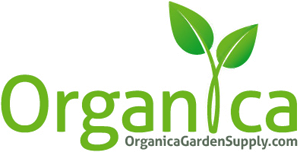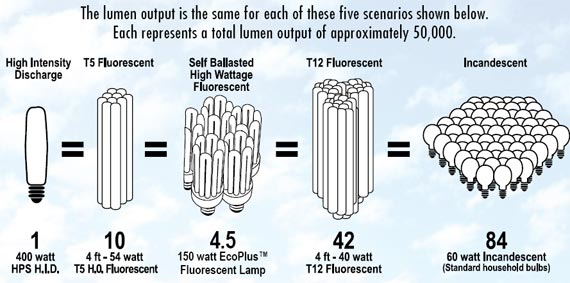What’s the difference? There are many different types of indoor grow lights on the market and many new emerging technologies. We continuously stay ahead of the game and current on all new light technologies. They all vary in price, intensity, & coverage. In the end, they all produce LIGHT. Light is mesasure in Lumens with a Light Meter and PAR with a PAR Meter. Below is a lumen out comparison of different lighting scenarios:
We will start with the most basic and end with the most complex lighting technologies. Below we break down the most popular and recommended grow lights on the market.
.
.
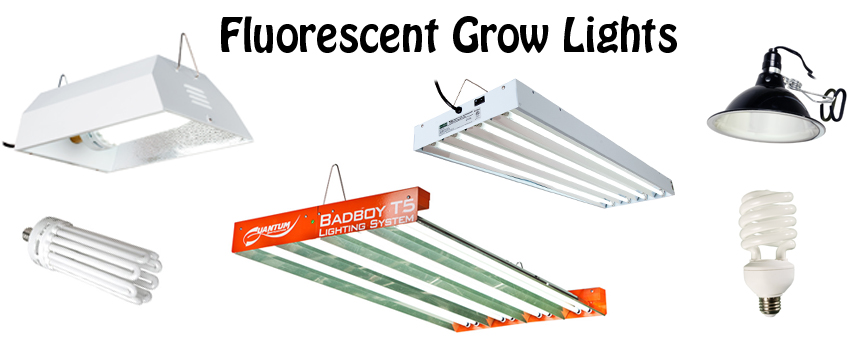
Fluorescent Grow Lights: CLICK HERE to see them in our Store!
Fluorescent grow lights are typically the least expensive and operate at a cooler temperature than other lights. Fluorescents also save energy when compared to HID lights. The only things they lack are intensity and coverage. Intensity in the VHO, XHO & HO have increased in recent years. There are 2 main types of fluorescent grow lights, CFL [compact fluorescent] and T5 fluorescent tubes. They are recommended for use in vegetative growth mostly. Only the VHO/XHO Fluorescent T5 units are recommended for fruiting and flowering.
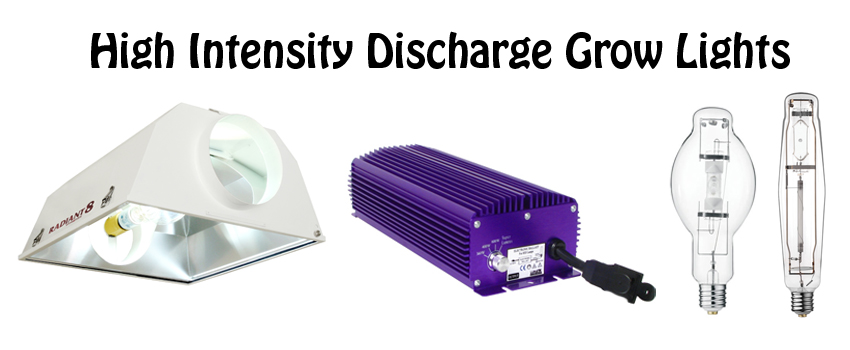
High Intensity Discharge – HID Grow Lights: CLICK HERE to see them in our Store!
High Intensity Discharge (HID) grow lights are the most common in indoor and greenhouse gardening. They are by far the most intense and cover the most area of your garden. This technology consists of a lighting ballast, lamp reflector, and HID Bulb. They are extremely powerful and generate the best yields. The disadvantage to HID lights are the amount of heat they generate and the amount of power they consume. As of now, HID lighting is still the standard indoor gardening light.
.
.
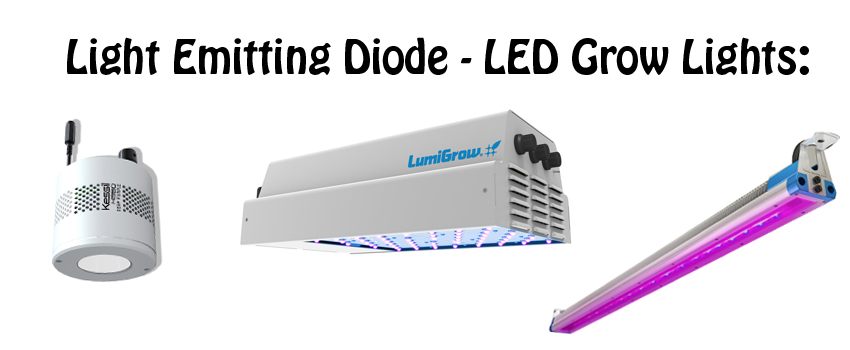
LED Grow Lights: CLICK HERE to see them in our Store!
Light Emitting Diode (LED) grow lights have advanced very much in the last few years. They are gaining popularity amongst hobbyist and commercial greenhouse growers. They are the most expensive of the types of grow lights, but have many advantages. LED grow lights produce very little heat compared to HID grow lights. LEDs also save a tremendous amount of energy and the diodes typically last 5-7 years. There is a great savings of energy, heat, and bulb replacement costs. The only disadvantages of LED lights at this time is the lack intensity and lack of coverage area. LED lights do not spread like HID lights, instead the light is focused straight and precise. LED lights also lack the intensity that HID grow lights produce, but the gap has narrowed in the latest high end LED models. The LED grow light market is a rapidly changing technology that keeps advancing. It is highly recommended for use in vegetative growth and supplemental flowering & fruiting. They may be used as sole light sources for flowering, but it’s important to use a reputable LED company with documented technology writings about their lights.
.
.
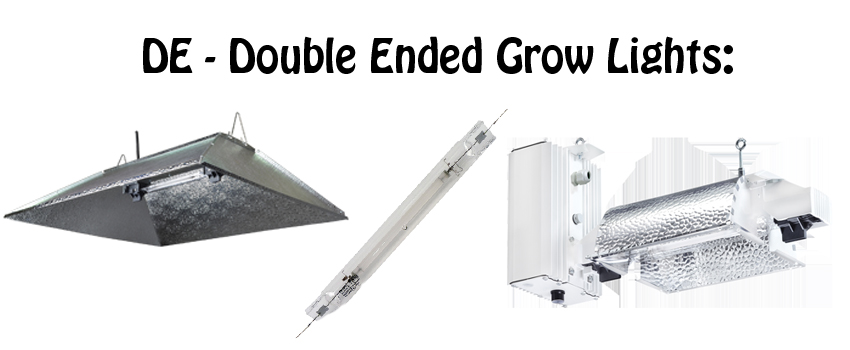
Double Ended (DE) Grow Lights: CLICK HERE to see them in our Store!
Double Ended or DE grow lamps are more efficient, can offer an improved light spectrum and have quicker warm up & re-strike times as well as improved lumen maintenance over the lifetime of the lamp. These bulbs are more efficient and the arc tube is a little bit longer. The electricity flows from one end of the arc tube and out the other. This makes them inherently more efficient than bulbs that require electricity to travel farther less efficiently. The new bulbs produce about 15% more light than single-ended bulbs. Since the bulb is attached at both ends, the arc tube is always mounted parallel to the reflector for maximum efficiency and reflection.
.
.

LEP – Plasma Grow Lights: CLICK HERE to see them in our Store!
LEP differs from traditional HID light sources such as Metal Halide or High Pressure Sodium lamps in a number of ways. First, LEP is powered using solid-state electronics that allow it to achieve very high reliability and have precise control over its operation. Also, unlike a traditional HID light source, the LEP bulb does not need metal electrodes to drive power into the source and therefore has a more robust quartz vessel eliminating early failure and lumen degradation. In addition, the light output from a LEP source is directional, easily dimmable, turns on and re-strikes rapidly, and can operate in any orientation. All of these advantages translate into lower installation, maintenance and operating costs, higher energy efficiency, and an overall better lighting experience to the end user. Plasma lights are advancing rapidly in this industry, but as of right now there are very little options with plasma lights but they have a bright future.
.
.
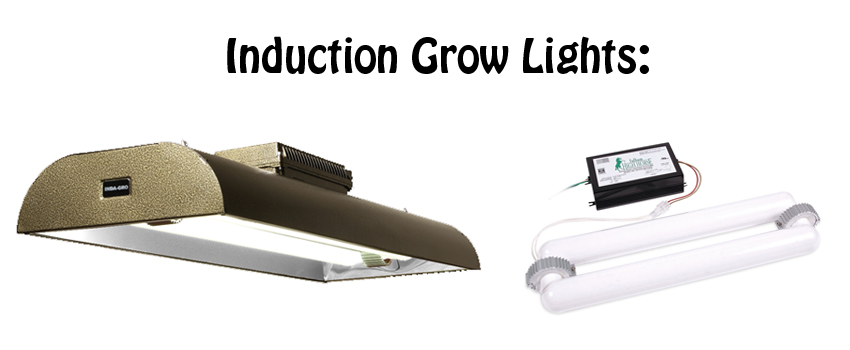
Induction Grow Lights: CLICK HERE to see them in our Store!
Induction lamps are a type of High Output Fluorescent lamp that are known as Electrode less Fluorescent Discharge Lamps or EFDL for short. Unlike conventional lamps which require screw in sockets or pins to power up the lamps, the EFDL induction lamp does not rely on a socket or pin connection to power the lamp. Instead EFDL efficiencies derive from being powered by a High Frequency Electromagnetic Field. Without the use of pins, sockets or ballasts to operate the lamp, more energy is converted into usable plant light and not wasted due to the high temperatures and escaping gas inefficiencies that is inherent of lamps requiring electrodes.
Induction lighting is on the expensive side, but offers an excellent choice for vegetative growth. Some growers complain about their intensity compared to HID lighting and compare yields similar to LED lighting.
- Saves up to 70% in electrical loads.
- Emits 95% PAR usable light.
- Excellent canopy penetration.
- Faster rooting of clones and seedlings
- Long life lamps and drivers.
- ~60,000 hour life.
- Highest lumens per watt of any lamp manufactured.
- Single lamp for vegetative through flowering stages.
- Low operating temperatures require no added ventilation.
70% shrink on photos
